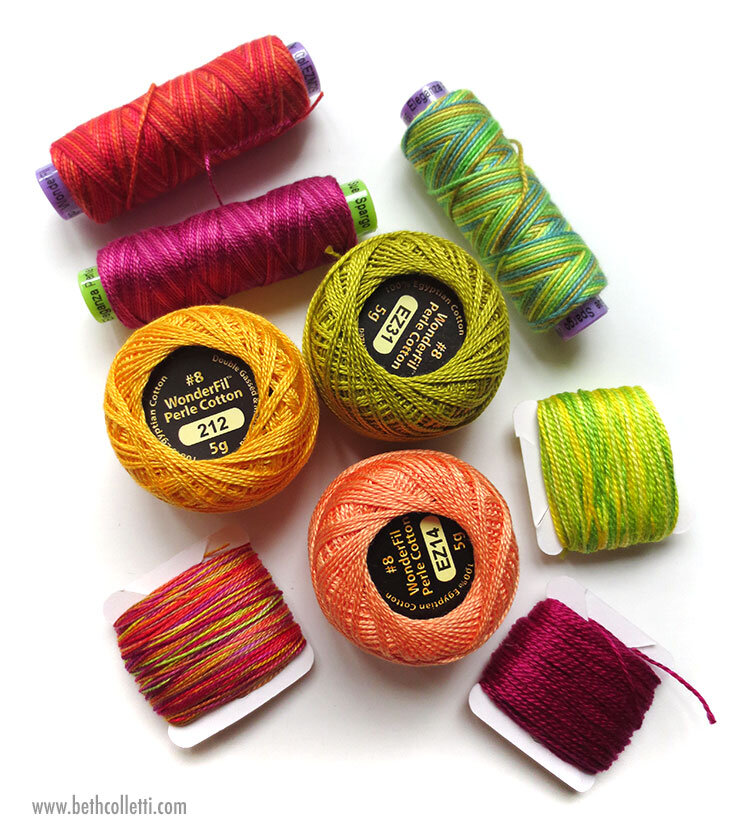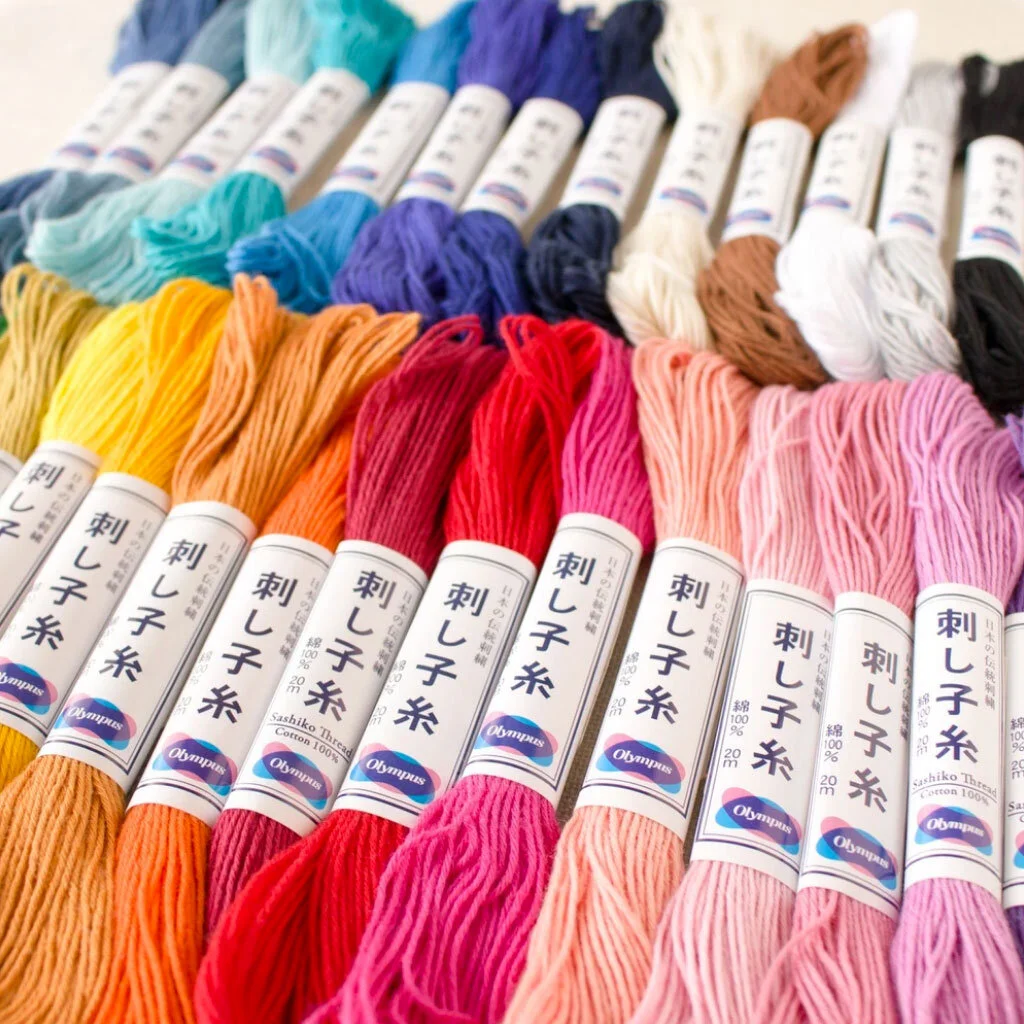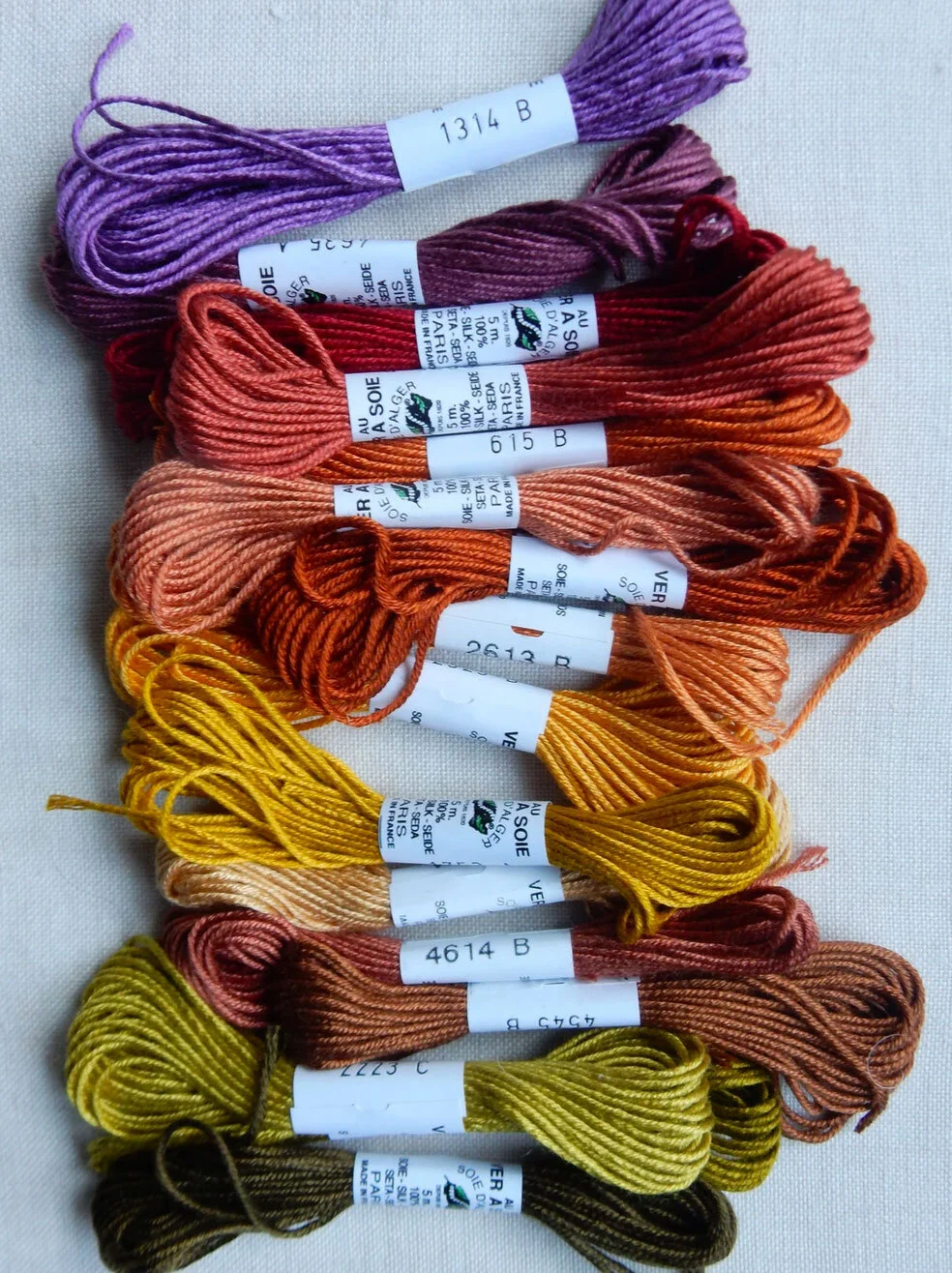(I am an Amazon Associate and from time to time will use affiliate links for products that I love, or that I think you will find useful.)
Years ago when I began dabbling in hand embroidery, I had no idea that I was just scratching the surface with the variety of threads that could be used. My first embroidery project was a crewelwork unicorn kit ;) and a little later I tried six-strand cotton embroidery floss. The more I stitched, the more I became fascinated by fiber and fabric and wanted to experiment with something new.
Like me, you may find that as your embroidery skills and experience have grown, you’re eager to try a wider range of threads for various stitches, effects, and techniques. If you’re ready to branch out and play with something new, here is a sampling of some threads that are great for embroidery. It all depends on the look and feel you want to attain!
Six-strand cotton embroidery floss
Six-Strand Cotton Embroidery Floss
What it is: One of the most popular and versatile types of thread for embroidery, six-strand cotton floss is made of 100% cotton. It’s a divisible thread, meaning that each of the six strands can be separated and used individually allowing you to stitch with one, two, three, four, five, or all six threads. Six-strand cotton embroidery floss is great if you’re just learning hand embroidery yet it’s accessibility and availability in hundreds of colors makes it a favorite for people of all skill levels.
Best for: Just about any type of hand embroidery project. It also launders well.
Recommended needles: A variety of Embroidery needles.
Check out: DMC and Anchor for their large selection and consistent colors which are widely available worldwide. Sublime Stitching also has some fun threads, and don’t forget to explore local hand-dyed varieties of floss.
Perle cotton threads
Perle (Pearl) Cotton Thread
What it is: Perle or pearl cotton thread is a non-divisible thread consisting of two strands twisted together. It’s available in four sizes: 3, 5, 8, and 12, with size 12 being the thinnest and size 3 being the thickest. Perle cotton has a lovely texture and creates a slightly raised effect when stitching, making it great for more textural stitches.
Best for: Just about any type of hand embroidery project. It’s especially beautiful with some more elaborate stitches because it’s less likely to tangle than six-strand cotton embroidery floss. Great for hardanger embroidery or embellishing felt appliqué.
Recommended needles: A variety of Chenille needles or Milliners needles (for certain stitches).
Check out: DMC and Anchor have a great variety of different sized and colored threads, especially variegated ones. Also be sure to explore Wonderfil Specialty Threads and Sue Spargo’s selection of perle cotton.
Sashiko thread. Photo Credit: Stitched Modern
Cotton Sashiko Thread
What it is: Sashiko thread is a strong, non-divisble 100% cotton thread which has a soft texture and matte look. It’s slightly heavier than size 8 perle cotton and is available in both solid and variegated colors.
Best for: Sashiko projects, boro mending or slow stitching. Sashiko thread is great for patching and launders well.
Recommended needles: For traditional Sashiko projects, Sashiko needles are best, however sashiko thread can be used with Chenille or Milliners needles for different applications.
Check out: Olympus sashiko thread which comes in a lovely variety of both solid and variegated colors.
Tapestry wool yarn
Tapestry Wool Yarn
What it is: Tapestry wool is a soft, smooth non-divisible 100% wool yarn. It’s much thicker than most other embroidery threads making it tougher to use in detailed stitching, but great for creating textures in embroidery.
Best for: Traditional Needlepoint or Bargello projects on plastic canvas, though also beautiful to embellish wool felt appliqué.
Recommended needles: A variety of Tapestry needles or larger Chenille needles.
Check out: DMC, Anchor and Appleton offer dozens of colors of tapestry wool.
Crewel wool thread
Crewel Wool Thread
What it is: Crewel wool is a 2-ply or 1-ply non-divisble 100% wool yarn. Available in a variety of colors, it’s thinner than Tapestry wool and lays flat when stitching.
Best for: Traditional Crewelwork, but it also makes a unique embellishing thread in wool felt appliqué.
Recommended needles: A variety of Crewel needles or Chenille needles.
Check out: Appleton’s beautiful variety of crewel wool.
Linen embroidery threads
Linen Embroidery Thread
What it is: Linen thread is a strong, durable thread with a rustic, matte finish made of 100% linen. Though strong, linen threads will wear out in the eye of the needle so it’s best to keep a short “tail” when stitching. Some people prefer to condition their linen embroidery threads with beeswax if they are unwaxed. This reduces friction and fraying, but changes the look of the thread and can darken the color over time.
Best for: Just about any type of hand embroidery project that you want to have a natural or rustic look.
Recommended needles: A variety of Embroidery needles.
Check out: Londonderry offers a beautiful variety of earthy linen threads in various weights and Linladin carries vintage linen embroidery threads from Sweden.
Spun silk threads. Photo credit: The French Needle
Spun Silk Threads
What it is: Spun Silk thread is made of bits of silk that are spun into thread. It’s a soft, delicate, slightly glossy thread that is divisible, similar to six-stranded cotton, and can be good for people who are new to stitching with silk. Because it is prone to breaking though, it’s best to work with shorter lengths of thread and a short “tail”.
Best for: A variety of hand embroidery projects, especially when blending colors or thread painting. It stitches similarly to six-strand cotton embroidery floss.
Recommended needles: A variety of Embroidery needles.
Check out: Soie d’Alger is a divisible seven-stranded silk thread and comes in hundreds of colors. Meanwhile Caron Waterlilies® offers twelve-ply hand-dyed variegated silk.
Au Ver À Soie ®, Soie Perlee filament silk. Photo credit: Access Commodities
Silk Filament Threads
What it is: 100% silk filament thread is stronger than Spun Silk thread and very glossy, offering a beautiful, rich look to your stitching. It can be either twisted or flat and comes in a wide variety of weights and colors.
Best for: Hand embroidery projects where you want a luxurious look to your work.
Recommended needles: A variety of Embroidery needles.
Check out: Au Ver a Soie makes several kinds of high quality twisted filament silks including Soie de Paris, Soie Perle and Soie Gobelins.
Silk chenille. Photo credit: The ThreadGatherer
Silk Chenille
What it is: Resembling a velvety cord, this chunky 100% silk thread offers a wonderful, plushy texture to embroidery. It’s a more delicate thread that can become worn by the eye of a needle so it’s best to work with shorter lengths and a short “tail”.
Best for: Embellishment stitches such as used in felt appliqué. It’s especially beautiful in textured surface stitches, straight stitches, or couching stitches.
Recommended needles: A variety of Chenille needles or size 1 Milliners needle.
Check out: The ThreadGatherer offers gorgeous, hand-dyed 'flat' chenille in a variety of colors. Au Ver a Soie has a beautiful selection as well.
Other Fibers and MaterialsThis list is hardly exhaustive and there are many, many other fibers out there that you can experiment with in your projects. For example, sea grass or gimp are unique options for textural embroidery. Metallic threads add a special sparkle for seasonal projects or can be used on their own in goldwork. And silk ribbon will open the door to a whole other embroidery niche. Even fibers such as rope, rick rack or hand spun yarn can be used with couching stitches!
When it comes to thread, there are endless combinations and choices that are limited only by your creativity and imagination. Choose one and see how you can incorporate it into a new stitching project that you’re working on!











